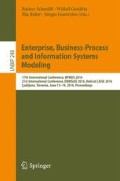Abstract
In enterprise modeling it is customary to differentiate between the current, as-is situation and the future to-be situation and develop models of these to plan for how to fill the gap. In practice you are never able to implement the ideal to-be model, each to-be will be incremental steps on the way to a future best practice. So it will be useful to also maintain a separate ought-to-be model, to not forget the situation you strive for. A distinction between the ought-to-be, as-is, and the to-be model is necessary, and we have in this paper provided the basis for an approach for combining top-down ought-to-be and bottom-up as-is and to-be modelling to support the dynamic interplay between these models. The approach is illustrated through a practical application in the healthcare sector. The main results is that it is found beneficial to represent the to-be and ought-to-be models separately, to be able to discuss the long-term goals without being hampered by short-term technical and organizational limitations, but still have support for developing the next version of the organization.
Access this chapter
Tax calculation will be finalised at checkout
Purchases are for personal use only
References
Aagesen, G., Krogstie, J.: Analysis and design of business processes using BPMN. In: vom Brocke, J., Rosemann, M. (eds.) Handbook on Business Process Management. International Handbook on Information Systems, pp. 213–235. Springer, Berlin (2010)
Alter, S.: A workaround design system for anticipating, designing, and/or preventing workarounds. In: Gaaloul, K., Schmidt, R., Nurcan, S., Guerreiro, S., Ma, Q. (eds.) BPMDS 2015 and EMMSAD 2015. LNBIP, vol. 214, pp. 489–498. Springer, Heidelberg (2015)
Bråten, S.: Model Monopoly and communications: systems theoretical notes on democratization. Acta Sociologica J. Scand. Socialogical Assoc. 16(2), 98–107 (1973)
Clancy, T.R., Effken, J.A., Pesut, D.: Applications of complex systems theory in nursing education, research, and practice. Nurs. Outlook 56(5), 248–256 (2008)
Conner, D.: Managing at the Speed of Change. Random House, New York (1992)
Dahl, Y., Sørby, I.D., Nytrø, Ø.: Context in care–requirements for mobile context-aware patient charts. Stud. Health Technol. Inform. 107(Pt 1), 597–601 (2004)
Dietz, J.: Enterprise Ontology. Springer, Berlin (2006)
Engen, R., Viljoen, S.: Citizen-centric Heathcare Delivery Reference Model (2015)
Fawcett, S.E., Cooper, M.B.: Process integration for competitive success: benchmarking barriers and bridges. Benchmarking: Int. J. 8(5), 396–412 (2001)
Fossland, S., Krogstie, J.: Modeling as-is, ought-to-be and to-be – experiences from a case study in the health sector. In: PoEM 2015, Valencia, Spain (2015)
Gilbreth, F.B., Gilbreth, L.M.: Process Charts. American Society of Mechanical Engineers, New York (1921)
Heggset, M., Krogstie, J., Wesenberg, H.: Understanding model quality concerns when using process models in an industrial company. In: Gaaloul, K., Schmidt, R., Nurcan, S., Guerreiro, S., Ma, Q. (eds.) BPMDS 2015 and EMMSAD 2015. LNBIP, vol. 214, pp. 395–409. Springer, Heidelberg (2015)
Houy, C., Fettke, P., Loos, P., van der Aalst, W.M.P., Krogstie, J.: BPM-in-the-large – towards a higher level of abstraction in business process management. In: Janssen, M., Lamersdorf, W., Pries-Heje, J., Rosemann, M. (eds.) EGES/GISP 2010. IFIP AICT, vol. 334, pp. 233–244. Springer, Heidelberg (2010)
Houy, C., Fettke, P., Loos, P., van der Aalst, W.M.P., Krogstie, J.: Business process management in the large. Bus. Inf. Syst. Eng. 3(6), 385–388 (2011)
IDEF0 (2016). http://www.idef.com/IDEF0.htm. Accessed 1 Mar 2016
Krogstie, J., Dalberg, V., Moe Jensen, S.: Process modeling value framework. In: Manolopoulos, Y., Fillipe, J., Constantopoulos, P., Cordeiro, J. (eds.) Enterprise Information Systems. LNBIP, vol. 3, pp. 309–321. Springer, Heidelberg (2008)
Krogstie, J.: Integrated goal, data and process modeling: from TEMPORA to model-generated work-places. In: Johannesson, P., Søderstrøm, E. (eds.) Information Systems Engineering From Data Analysis to Process Networks, pp. 43–65. IGI, Hershey (2008)
Krogstie, J.: Model-Based Development and Evolution of Information Systems: A Quality Approach. Springer, London (2012)
Lillehagen, F., Krogstie, J.: Active Knowledge Modeling of Enterprises. Springer, Heidelberg (2008)
Moody, D.L.: Theorethical and practical issues in evaluating the quality of conceptual models: current state and future directions. Data Knowl. Eng. 55, 243–276 (2005)
Nelson, H.J., Poels, G., Genero, M., Piattini, M.: A conceptual modeling quality framework. Softw. Qual. J. 20, 201–228 (2011)
Open Group Archimate 2.1 Standard. http://pubs.opengroup.org/architecture/archimate2-doc/toc.html. Accessed 30 Mar. 2016
Price, R., Shanks, G.: A semiotic information quality framework: development and comparative analysis. J. Inf. Technol. 20(2), 88–102 (2005)
Recker, J.C., et al.: Business process modeling : a comparative analysis. J. Assoc. Inf. Syst. 10(4), 333–363 (2009)
Silver, B.: BPMN Method and Style. Cody-Cassidy Press, Aptos (2012)
Stabell, C.B., Fjeldstad, Ø.D.: Configuring value for competitive advantage: on chains. Shops Netw. Strateg. Manag. J. 19, 413–437 (1998)
TOGAF (2016). https://www.opengroup.org/togaf/. Accessed 1 Mar 2016
Troux Architect (2016). http://www.troux.com/. Accessed 1 Mar 2016
Weick, K.: Sensemaking in Organisations. Sage, London (1995)
Weske, M.: Business Process Management: Concepts, Languages, Architectures. Springer Verlag Inc., New York (2007)
Author information
Authors and Affiliations
Corresponding author
Editor information
Editors and Affiliations
Rights and permissions
Copyright information
© 2016 Springer International Publishing Switzerland
About this paper
Cite this paper
Fossland, S., Krogstie, J. (2016). Enterprise Process Modeling in Practice – Experiences from a Case Study in the Healthcare Sector. In: Schmidt, R., Guédria, W., Bider, I., Guerreiro, S. (eds) Enterprise, Business-Process and Information Systems Modeling. BPMDS EMMSAD 2016 2016. Lecture Notes in Business Information Processing, vol 248. Springer, Cham. https://doi.org/10.1007/978-3-319-39429-9_23
Download citation
DOI: https://doi.org/10.1007/978-3-319-39429-9_23
Published:
Publisher Name: Springer, Cham
Print ISBN: 978-3-319-39428-2
Online ISBN: 978-3-319-39429-9
eBook Packages: Business and ManagementBusiness and Management (R0)

